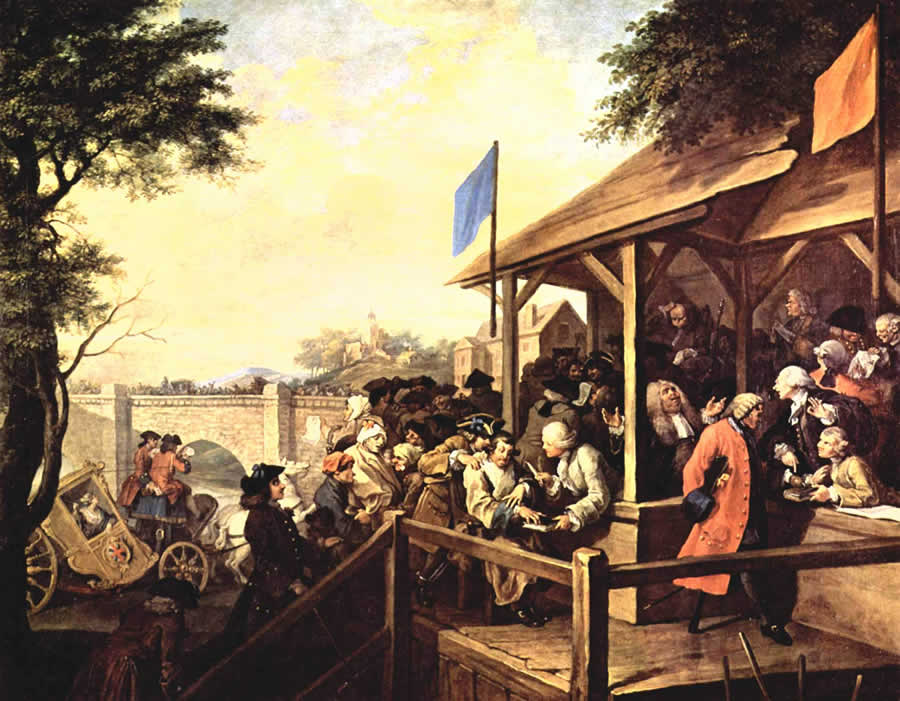 |
| Political Parties in Canada |
As the British Empire regrouped after the shock of losing 13 of its North American colonies in the American Revolution, Canadian politics began to evolve from rudimentary local and regional councils almost entirely dominated by royal governors-general and their lieutenants to genuinely competitive political parties that contested specifically Canadian problems and issues.
At the outset, Canadian politicians identified themselves as Tories or Whigs, in emulation of Britain’s parliamentary division of the late 18th and 19th centuries. Canada’s Colonial Office and its royal governors worked closely with members of local or provincial ruling elites who had the most to gain by toeing the imperial line.
Religious leaders (including Roman Catholics in French Canada and Church of England clerics in Ontario) and wealthy merchants were often part of this Tory oligarchy.
  |
After Britain’s War of 1812 with the United States, during which Canada survived American invasion, new voices of political reform began to emerge in opposition to this decidedly nonrepresentative system of power.
French-Canadian Louis-Joseph Papineau, a lawyer and French nationalist, in 1815 was elected speaker of the Lower Canada assembly, in defiance of the Chateau Clique’s previous stranglehold on that body.
This was an early indication that British governors were losing their ability to shape and manage local legislatures. In Upper Canada, businessman turned journalist William Lyon Mackenzie put forth a strong reform agenda and collaborated with Papineau.
Despite having his presses smashed by Tory opponents, by 1828 Mackenzie, an admirer of the U.S. political system and its incoming president, Andrew Jackson, won a seat and joined a new reform majority in Upper Canada’s assembly.
The reformers were poorly organized and faced powerful opposition. The so-called Family Compact—Tory leaders in Upper Canada supported by the British governor and Colonial Office—blocked reform proposals targeting patronage and tax policies, and, by 1831, had regained control.
Even though Britain’s Whigs managed in 1832 to implement major electoral reforms at home, Canadian reformers still despaired of change without radical action. For Canada, the 1830s were a period of political confusion and rising conflict, culminating in the Rebellion of 1837.
It was a year of desperation, caused largely by crop failures and a serious economic depression afflicting both Canada and the United States. In Québec, Papineau seemed to incite his supporters to boycott British trade and adopt some American political practices.
Mackenzie encouraged farmers to rally in Toronto to overthrow the existing Ontario government. British-led troops put down both schemes with minimal bloodshed but almost 100 arrests and several executions; both Papineau and Mackenzie fled temporarily to the United States.
Militarily the uprisings were a fiasco, but they caused Britain to look much more seriously at Canadian unrest and its potential threat to Britain’s colonial system. In 1838 John Lambton, earl of Durham, was sent by London’s Whig government to restore order and recommend new political arrangements that would ultimately establish Canadian self-government.
Lord Durham’s groundbreaking Report on the Affairs of British North America did not instantly solve Canada’s political malaise but helped Canadian politicians plan strategies for local self-rule. Most immediately, the Durham Report paved the way for a single legislative assembly for what was now called the Province of Canada, in which both Upper and Lower Canada were equally represented.
This move strengthened the importance of the two most populous regions of Canada, but also raised new concerns about French versus English political power: issues that have continued to roil Canadian politics.
New sectional and ideological parties began to appear in the 1840s and ’50s, as Canadians extended their autonomy. In Québec, a new Parti Rouge espoused French cultural supremacy while attacking its own Catholic clergy.
Canadians in the growing western region, feeling underrepresented by traditional politics back east, in the 1850s formed the Clear Grit Party that focused on agrarian interests, free trade, and more democratic voting rights. It took a young politician from Kingston, Ontario, John A.
Macdonald, to revitalize Upper Canada’s hidebound Tory tradition by accepting moderate reform and reaching out across the English-French cultural, religious, and political divide. Soon Macdonald’s new Liberal-Conservative party was winning elections with its French partner, Parti Bleu.
With the coming of Canadian Confederation, the Liberal-Conservatives governed Canada from 1867 to 1896, except for 1874–78 when the Reform, or Liberal Party, headed by Alexander Mackenzie won control of Parliament.
A Scottish-born stone mason not related to William Lyon Mackenzie, Alexander Mackenzie benefited from a Pacific railway bribery scandal that forced Macdonald’s resignation. During their tenure, the Liberals created the Canadian Supreme Court and instituted the secret ballot, among other electoral reforms.
Winning support almost exclusively in Ontario, the Liberal party lost badly in the 1878 general election. Not until Wilfrid Laurier became his party’s leader and, in 1896, Canada’s first French-Canadian prime minister, would the Liberal party truly become a competitive Canadian political institution.